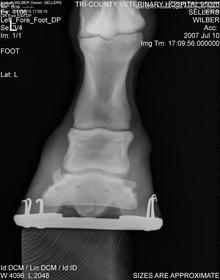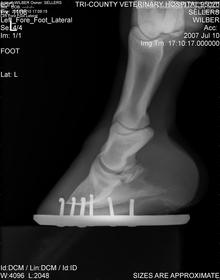
Very few horses have straight perfectly conformed legs when viewed from in front or the rear.
For many years it was popular to trim the hooves lower on one side in an effort to straighten the legs. This temporary solution would often make the horse lame and sometimes even permanently cripple the horse due to the stress placed on the leg’s joints and ligaments. Wall cracks would result, especially if the hoof was dry.

Angular limb deformity - Dorsiplantar view
This horse has an angular deformity that results in quarter cracks if the deformity is not considered by the farrier.
Twenty years ago a popular fad involved trimming the wall of horses with crooked limbs so that the coronary band was parallel to the ground. Again, this was a temporary fix since that did not last. The uneven weight bearing caused by the limb’s angular deformity would cause the hoof to further distort since the stiffer crooked bones and joints caused the distortion of the softer yielding hoof.
Recognizing that there are no perfectly conformed horses that match the ideal textbook horse, it seems reasonable that we should try to accommodate the deformity, and make the horse as comfortable as possible. This can be done by trimming the hoof so its base is perpendicular to the axis or center of gravity of the limb and placing a shoe as close to the center of gravity as is safely possible.
So in the case of your horse after trimming perpendicular to its limb axis, if it stands toed-in, you would place the shoe full or wider than the hoof on the outside where it would be closer to being under the limb’s center of gravity, and if it stands toed-out, the shoe would be full or wider than the foot on the inside for the same reason.

Angular limb deformity - Lateral view
This lateral view of the same horse and limb shows a relatively thin sole that may increase foot pain susceptibility.
Composite material can be glued on the shoe extensions and hoof to prevent the wider shoes from being stepped off during the shoeing interval. The object is to get the hoof to land as close to flat as possible as the horse moves to minimize strain on the joints and ligaments. A shoe with a rocker-toe also relieves stress.
Uneven weight bearing on the hoof causes quarter cracks. The side that loads last and most abruptly as the horse moves will be subject to wall cracks and sheared heels.
Trimming the base of the limb perpendicular to the axis or center of gravity of the limb will create a more uniform pressure on the coronary band and prevent cracks. Cracks must be immobilized to allow healing of torn sensitive tissue. Accurate trimming and support of the flexible hoof capsule with a rigid bar shoe is needed in addition to a composite or plate patch that immobilizes the crack while the hoof wall grows down and the crack grows out.
